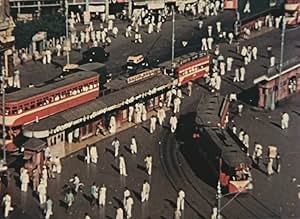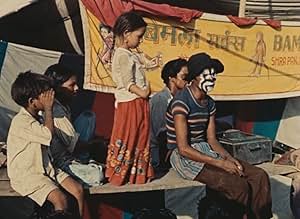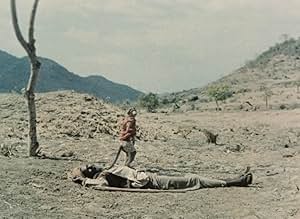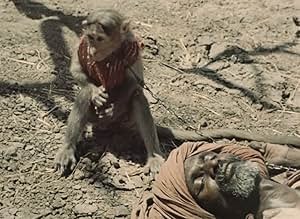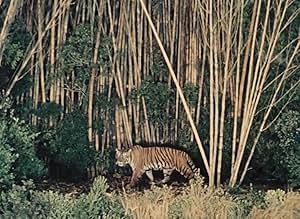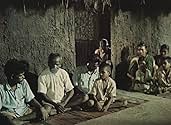IMDb-BEWERTUNG
7,2/10
778
IHRE BEWERTUNG
Füge eine Handlung in deiner Sprache hinzuSeveral stories depicting the landscapes and fauna of India are mixed with documentary footage.Several stories depicting the landscapes and fauna of India are mixed with documentary footage.Several stories depicting the landscapes and fauna of India are mixed with documentary footage.
- Auszeichnungen
- 2 Nominierungen insgesamt
Empfohlene Bewertungen
The film takes a look at then-current India, from the crowded cities to the rural farm country, and to large civil engineering projects intended to modernize and make more accessible remote and inhospitable areas. The color footage is nice to look at (there's a lengthy prologue to the copy I watched explaining the recent restoration efforts made to make the film more presentable after being available only in faded and deteriorated prints for decades), and the narration is okay. However, for some reason Rossellini decided to stage a handful of scenes and situations for dramatic effect, only to have these portions undermine the documentary effort elsewhere. These scripted scenes include a clumsy marriage proposal between a farmer and a traveling performer, another couple suffering marital strife against the background of a major construction project, and a performing spider monkey who loses her master and wanders the countryside.
This episodic film, shot in 1956 and released in 1959, deals mostly with vignettes of life in rural India. It is not a documentary, since the episodes are obviously scripted and performed by amateur actors (probably villagers, themselves). Apparently, India's leader at the time, Nehru, asked famous Italian director Roberto Rossellini to make this movie (whether the Indian president or other authorities like the end result, I don't know).
The director praises through the narrator the widespread tolerance of the Indian people, and we soon see the diversity and vitality of the country. After a brief introduction in Mumbai, we move to what the movie calls the "real India", that is, the India of the villages. We see elephants being forced to work as loggers, a puppet show, an illiterate elephant runner having his father arrange a marriage with a local farm girl, a worker in a nearly completed dam knowing he will soon have to move with his family to another place (despite the desperate pleas of his nagging, complaining wife), an elderly villager having to deal both with the presence of man killing tigers nearby and the arrival of government mining prospectors, and, in the best story, a performing monkey chained to its master who has to escape when he suddenly collapses in the heat and is surrounded by vultures. As you can see, animals are as much the stars of this movie as people, as we see elephants, tigers, monkeys, cows, vultures. It is not very well known film, and it can be accused of being a tad folkloric, but is very much worth watching, especially in a copy with its color restored.
The director praises through the narrator the widespread tolerance of the Indian people, and we soon see the diversity and vitality of the country. After a brief introduction in Mumbai, we move to what the movie calls the "real India", that is, the India of the villages. We see elephants being forced to work as loggers, a puppet show, an illiterate elephant runner having his father arrange a marriage with a local farm girl, a worker in a nearly completed dam knowing he will soon have to move with his family to another place (despite the desperate pleas of his nagging, complaining wife), an elderly villager having to deal both with the presence of man killing tigers nearby and the arrival of government mining prospectors, and, in the best story, a performing monkey chained to its master who has to escape when he suddenly collapses in the heat and is surrounded by vultures. As you can see, animals are as much the stars of this movie as people, as we see elephants, tigers, monkeys, cows, vultures. It is not very well known film, and it can be accused of being a tad folkloric, but is very much worth watching, especially in a copy with its color restored.
As a documentary, Rossellini's film suffers from feeling too much like "exotic" India as portrayed through Western eyes, and with rose-tinted glasses on top of it. As a series of short stories, it suffers from being too simple, with characters that are hardly developed and indeed not enough subtitled when they're talking to one another. But oh, the images he captured of this country are simply gorgeous, and the occasional bits of philosophy profound, even if he barely scratched the surface. There's no wonder that this was one of his personal favorites, as it must have been quite an experience to be there. It seems he was doing a little more than admiring the scenery, much to Ingrid Bergman's displeasure, but that's another matter. The film's a hodgepodge, a mixed bag - there is undeniably something here worth seeing, but it's a very scattershot view of India, and not what it could have been. Check out one of Satyajit Ray's films from this period instead.
Not an easy movie, and certainly it is not going to get a "blue sticker" from the pundits of post-colonial thought... but "Born into Brothels"? Ple-ease! A washed-out late night Hollywood-esquire expose' good for Anderson Cooper, maybe. Rossellini spent a year in India shooting a ten-hour documentary, and this little fiction film "India Matri Bhumi". The need for restoration is obvious, but the process of de-spectacularization is in full effect: a full frontal attack on the society of the spectacle at its incepts, by making an imperfect film, where ends don't meet, and birds sing freely. I take Rossellini over any postcolonial melancholic!
I first read about "India, Matri Bhumi", an amazingly visionary though largely forgotten documentary from Roberto Rossellini, when one of my favorite critics Andrew Sarris mentioned it in his Film Culture essay on Rossellini back in the 60s. Sarris calls the documentary "one of the prodigious achievements of the century". So it piqued my interest since then. And then I read several critics' writings on the film, including film historian Tag Gallagher in his magnificent recent biography, THE ADVENTURES OF ROBERTO ROSSELLINI. I wasn't able to watch it until recently when I viewed it along with several other Rossellini films. Though it is apparently not for every taste like most of Rossellini's work, "India" is undoubtedly on a short list of director's masterpieces. If you are a fan of the director, this is definitely worth catching. The documentary is basically an episodic portrait on India, circa 1957-1958; It captures life in flux at that moment in time. "India" is divided into four sections, each documenting the strange interaction between humans and animals, tradition and technology. The first section, after the opening shots of people walking in the streets, deals with some elephants taking bath; the second part concerns a labor worker in a dam; the third part is about an old man and a man-eating tiger; the fourth and most remarkable section involves the desperate attempts of a pet monkey whose master has died of heat wave. What surprised me the most about "India" is Rossellini's camera movements. Rossellini uses a combination of circular, swooping tracking shots, pans, and zoom to conjure up a strange yet personal vision of India, something that is almost very hard to describe in words. The color photography is also rich and fascinating.
I definitely recommend reading Gallagher's chapter on "India" in his book on Rossellini.
I definitely recommend reading Gallagher's chapter on "India" in his book on Rossellini.
Wusstest du schon
- WissenswertesSonali Senroy DasGupta, then Rosselini's wife produced the film,
- Zitate
Narrator: When faced with death, the general belief is that when a man dies, his life doesn't end, because he's reincarnated in another. But no one knows in whom. Therefore, all men are brothers.
- VerbindungenReferences Unter dem Mantel der Nacht (1956)
Top-Auswahl
Melde dich zum Bewerten an und greife auf die Watchlist für personalisierte Empfehlungen zu.
Details
- Laufzeit1 Stunde 30 Minuten
- Sound-Mix
- Seitenverhältnis
- 1.37 : 1
Zu dieser Seite beitragen
Bearbeitung vorschlagen oder fehlenden Inhalt hinzufügen

Oberste Lücke
By what name was Indien, Mutter Erde (1959) officially released in Canada in English?
Antwort
